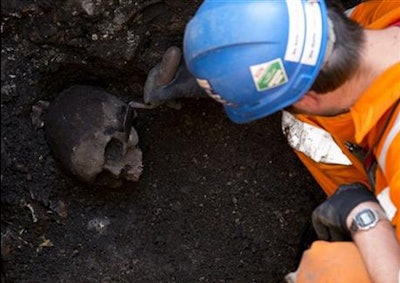 An archaeologist uncovers a skull as construction continues on London’s Crossrail commuter line. Credit: Alastair Grant/AP
An archaeologist uncovers a skull as construction continues on London’s Crossrail commuter line. Credit: Alastair Grant/APThe 73-mile, $23 billion Crossrail commuter line is Britain’s largest construction project. Tunneling for the project’s 13-mile underground rail is advancing at a rate of 330 feet per week, and while constructing an exciting part of London’s future, the crews have uncovered a great deal of the city’s past.
In the 16 to 20 feet of soil beneath London’s current streets, there’s about 2,000 years-worth of history, according to a report from the Associated Press. Because of that, more than 100 archaeologists have dropped in for excavations at more than 40 sites over the past four years of construction.
So far, the archaeologists have enjoyed a massive haul.
Their discoveries include: a chunk of Roman road; dozens of 2,000-year-old horseshoes; 17th-century jewelry; reindeer, bison and mammoth bones dating back 68,000 years; flint, some of which was shaped into tiny blades by a 9,000-year-old tool-making factory beside the Thames River; remains of a moated Tudor manor; medieval ice skates; a piece of an 800-year-old ship and the foundations of an 18th-century shipyard.
And did we mention the 16th century cemetery containing the remains of 20,000 people?
“Everyone’s been running around in Liverpool Street for years and not thinking that they’ve been walking around on bodies from one of the densest burial grounds in London,” Nick Elsden, a Museum of London archaeologist, told the AP.
Archaeologists overseeing the tunneling have also unearthed skeletons belonging to victims of the Black Death, the plague that wiped out half of London’s population in 1348.









